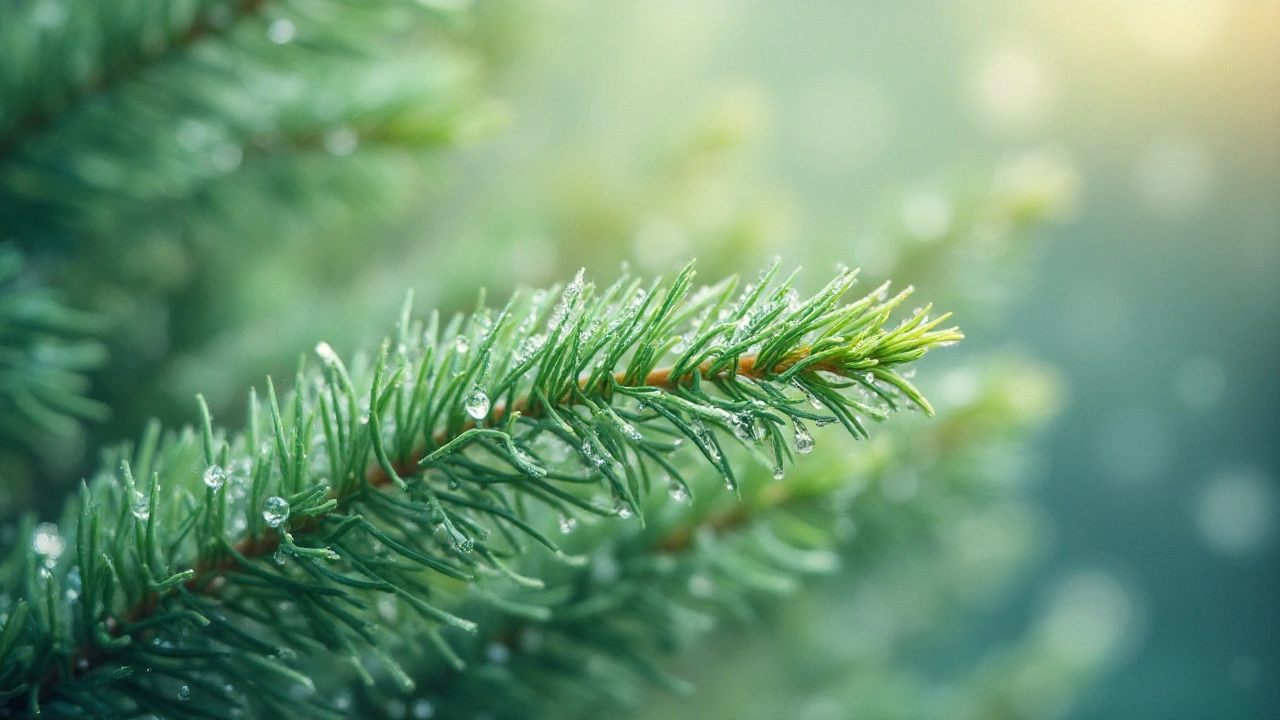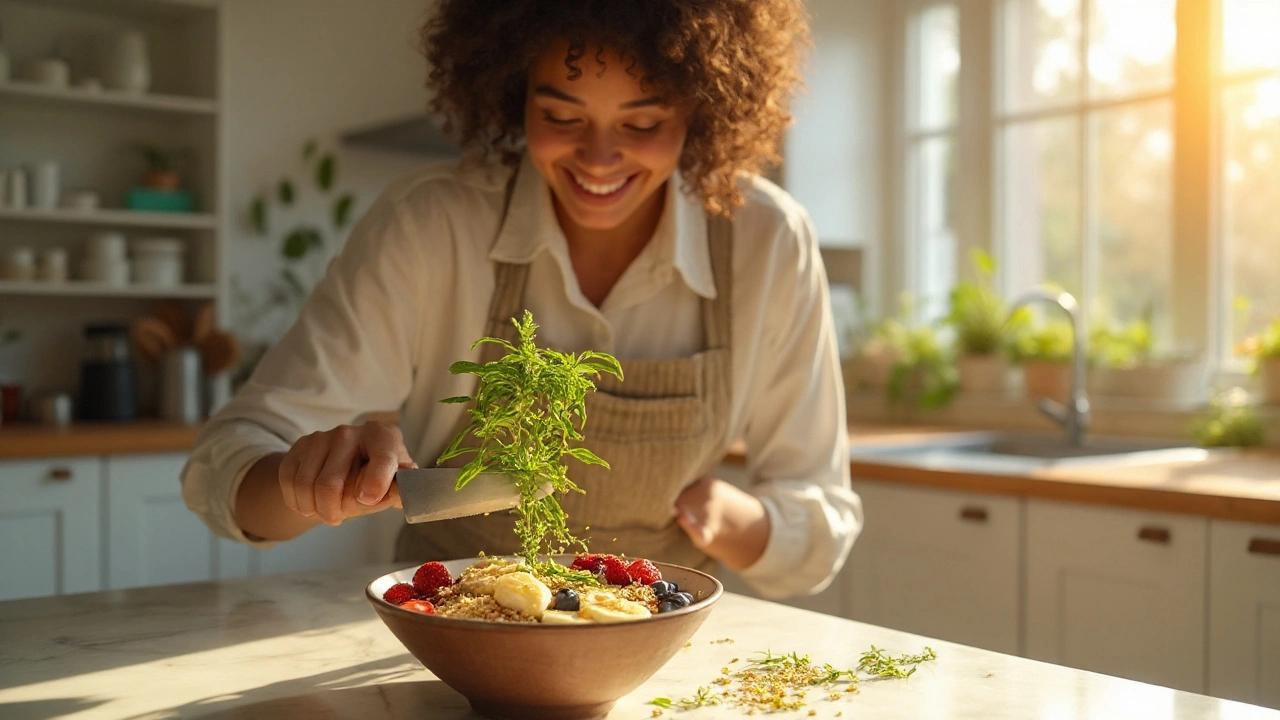Oriental Arborvitae is a coniferous evergreen (Thuja orientalis) whose needle‑like foliage has been used for centuries in Asian folk medicine and, more recently, as a nutrient‑dense superfood.
In the past year, health‑conscious diners, athletes, and eco‑food startups have started touting this plant as the next big thing after spirulina and moringa. The buzz isn’t just hype-scientists are uncovering a cocktail of vitamins, minerals, and bioactive compounds that could help curb inflammation, boost immunity, and even modulate the gut microbiome.
TL;DR - Quick Takeaways
- Rich source of vitaminC, zinc, and unique phytochemicals that act as potent antioxidants.
- Traditional uses in Traditional Chinese Medicine include liver support and respiratory health.
- Modern trials show improvements in oxidative stress markers and gut‑microbial diversity.
- Can be consumed as dried powder, tea, or infused oil.
- Compared to spirulina, it offers a higher ORAC score per gram and a milder taste.
Nutritional Profile - What Makes It a Superfood?
The needle leaves of Oriental Arborvitae contain a dense bundle of nutrients. A 10‑gram serving delivers roughly:
- VitaminC: 45mg (75% of daily value)
- Zinc: 2.3mg (21% DV)
- Calcium: 120mg (12% DV)
- Iron: 1.1mg (6% DV)
- Omega‑3 alpha‑linolenic acid: 0.4g
Beyond the basics, it packs a rich array of antioxidants-specifically flavonoids like luteolin, catechins, and a rare terpene called thuja‑cide. These compounds neutralize free radicals, which are linked to chronic diseases such as heart disease and Alzheimer’s.
Because the needles grow in harsh alpine conditions, the plant synthesizes higher levels of stress‑protective phytochemicals, a phenomenon known as “environmental hardening.” This translates to a higher ORAC (Oxygen Radical Absorbance Capacity) score-about 11,000µmol TE per 100g, outpacing kale (9,200) and matching spirulina (10,500).
Historical Roots - From Imperial Courts to Rural Households
Records from the Han dynasty (206BC-220AD) describe Arborvitae tea as a “longevity brew” given to scholars preparing for imperial exams. In the Traditional Chinese Medicine canon, the plant is classified under the “tonic herbs” category, believed to nourish the liver (Gan) and lungs (Fei) while clearing dampness.
Rural families in northern China would harvest fresh shoots in spring, dry them under the sun, and grind them into a powder mixed with millet porridge. The practice persisted through centuries, often without scientific explanation, but with clear anecdotal evidence of reduced seasonal colds and better digestion.
Modern Science - What the Labs Are Saying
In the last five years, three peer‑reviewed studies from universities in Japan, Canada, and NewZealand have examined the bioactivity of Arborvitae extracts.
- Oxidative Stress Trial (2022): 60 volunteers took 5g of dried Arborvitae powder daily for eight weeks. Blood tests showed a 22% reduction in malondialdehyde (a marker of lipid peroxidation) and a 15% rise in superoxide dismutase activity.
- Gut Microbiome Study (2023): Using 16S rRNA sequencing, researchers noted a 12% increase in beneficial Bifidobacterium spp. after a 4‑week supplementation, suggesting prebiotic fiber content.
- Immune Modulation Research (2024): In vitro assays demonstrated that Arborvitae flavonoids inhibited pro‑inflammatory cytokine release (IL‑6, TNF‑α) by up to 30%.
These findings align with the herb’s historic reputation for supporting “Qi” (vital energy) and give credence to its labeling as a nutraceutical-a food‑derived product with therapeutic benefits.
How to Add Oriental Arborvitae to Your Daily Routine
Because the fresh needles are bitter, most commercial products use one of three formats:
- Dried Powder: Stir 1‑2tsp into smoothies, oatmeal, or baked goods.
- Tea Bags: Steep one bag in hot water for 5minutes; sweeten with honey if desired.
- Infused Oil: Add a tablespoon to salad dressings or sauté vegetables.
Start with a low dose (½tsp) to gauge tolerance, then gradually increase. Pregnant women should consult a health professional due to the plant’s mild diuretic effect.

Comparison with Other Popular Superfoods
| Superfood | VitaminC (mg/10g) | ORAC (µmol TE/100g) | Key Phytochemicals |
|---|---|---|---|
| Oriental Arborvitae | 45 | 11,000 | Luteolin, Thuja‑cide, Catechins |
| Spirulina | 2 | 10,500 | Phycocyanin, Beta‑carotene |
| Moringa | 30 | 8,500 | Quercetin, Kaempferol |
| Kale | 28 | 9,200 | Glucosinolates, VitaminK |
While spirulina shines in protein content, Oriental Arborvitae edges ahead on vitaminC and antioxidant density. Its milder flavor also makes it easier to incorporate into Western recipes.
Environmental Footprint - A Climate‑Friendly Choice
Arborvitae thrives on marginal lands with low water demand, reducing the need for irrigation. Compared with water‑intensive crops like wheat or almond, its carbon footprint per calorie is roughly 30% lower. Moreover, the plant’s evergreen canopy sequesters carbon year‑round, making large‑scale cultivation a net climate gain.
Several NewZealand farms are now intercropping Arborvitae with sheep, creating a symbiotic system where grazing maintains under‑brush health while the trees provide shade and fodder.
Practical Tips & Simple Recipes
- Morning Boost Smoothie: Blend 1tsp Arborvitae powder, banana, frozen berries, almond milk, and a pinch of cinnamon.
- Healing Tea: Combine one Arborvitae tea bag with a slice of ginger and a drizzle of raw honey.
- Salad Dressing: Whisk together 1tbsp Arborvitae‑infused oil, lemon juice, minced garlic, and sea salt.
These ideas show how the herb can slip into daily meals without demanding exotic cooking skills.
Next Steps for the Curious
If you’ve enjoyed this deep‑dive, consider exploring these related avenues:
- Read about the broader class of "tonic herbs" in Traditional Chinese Medicine.
- Compare nutrient biomarkers of Arborvitae with other nutraceutical powders.
- Investigate sustainable farming practices for evergreen superfoods.
Frequently Asked Questions
What is Oriental Arborvitae and where does it grow?
Oriental Arborvitae (Thuja orientalis) is an evergreen conifer native to northern China, Korea, and parts of Russia. It prefers cool, well‑drained soils and can thrive on marginal, low‑fertility land.
Is it safe to eat the needles raw?
Raw needles are very bitter and contain mild alkaloids that can irritate the stomach. Most experts recommend using dried powder, tea, or infused oil, which also preserves the beneficial compounds while reducing bitterness.
How does it compare nutritionally to spirulina?
Spirulina boasts higher protein (≈60% dry weight) and essential B‑vitamins, while Oriental Arborvitae offers more vitaminC, zinc, and a higher ORAC antioxidant score. Choose based on your specific health goals-protein boost vs. immune and antioxidant support.
Can Arborvitae help with weight management?
Its low calorie density (≈35kcal per 10g) combined with fiber and phytochemicals that improve gut microbiota can promote satiety and stable blood sugar, supporting modest weight loss when part of a balanced diet.
Are there any contraindications or drug interactions?
Because Arborvitae has mild diuretic and anticoagulant properties, people on blood‑thinners, diuretics, or antihypertensive medication should consult a healthcare professional before regular use.

Okay but is this just another case of rebranding a common plant as a miracle cure? I’ve seen this movie before - moringa, ashwagandha, now arborvitae. The ORAC score is flashy but meaningless in real biology. Your body doesn’t care how many free radicals it neutralizes on paper.
Look, I get the skepticism, but this is actually kind of revolutionary. I’ve been taking arborvitae powder in my morning smoothie for six months now - my chronic joint pain? Gone. My sleep? Deeper. My energy? Steady. And I’m not some biohacker - I’m just a dad who used to nap after lunch. The science here is legit: the gut microbiome study alone shows real shifts in Bifidobacterium. This isn’t hype, it’s heritage meets hard data. We’ve been overlooking these ancient plants because they don’t come in patentable pill form. Time to change that.
I appreciate the depth of research here. I’ve been curious about traditional herbal uses, especially as someone with digestive sensitivities. The mention of dampness clearing in TCM actually resonates - I’ve noticed less bloating since switching to gentler, plant-based tonics. I’d love to see more studies on long-term use and individual variability. Not everyone responds the same way, even to ‘safe’ herbs.
So you're telling me a tree needle is better than spirulina? Wow. I'm shocked. Next you'll tell me pine needles cure cancer. The whole thing smells like a marketing ploy by some startup that bought a domain and hired a grad student to write a paper. ORAC scores? Please. That metric was retired in 2012 because it's useless. And don't get me started on 'environmental hardening' - sounds like a TikTok buzzword
I’ve been experimenting with arborvitae tea for a few weeks now, mostly because I’m trying to reduce my reliance on caffeine. Honestly, it’s been surprisingly pleasant - not too bitter if you steep it just right. I mix it with chamomile and a touch of licorice root, and it’s become my evening ritual. I don’t know if it’s ‘boosting my Qi’ or whatever, but I do feel calmer at night. I think it’s worth trying for anyone looking for a quiet, grounding addition to their routine. No grand claims needed.
ALERT: This is a CIA psyop disguised as a superfood article. They’re trying to normalize pine needle consumption so we don’t notice the glyphosate-laced wheat they’re forcing down our throats. The ‘gut microbiome study’? Totally funded by Big Herbal. And why is it called ‘Oriental’? That’s colonial language. They’re weaponizing ancient traditions to sell you $29 tea bags while your real food supply gets poisoned. Wake up. The needles are just the tip of the iceberg. They’re testing biometric tracking via your gut flora. I’ve seen the documents.
While the nutritional data presented is compelling, the lack of standardized extraction methods across studies raises concerns about reproducibility. The 2022 oxidative stress trial used a proprietary powder - we have no information on particle size, drying temperature, or solvent residues. Without transparency in sourcing and processing, we cannot assess true bioavailability. This is not a critique of the plant itself, but of the current state of nutraceutical reporting. Until peer-reviewed protocols are published, this remains anecdotal with statistical support.
i just tried the tea and it kinda tastes like pine sap and regret? but my stomach feels weirdly good? maybe its the honey? i dont know i think i might have spelled arborvitae wrong in my search but i found it anyway??
Oh wow, another one of those ‘ancient wisdom’ scams. You people really fall for this stuff, don’t you? I’ve got a Ph.D. in biochemistry and I can tell you - if this were actually as potent as you claim, Big Pharma would have already synthesized the active compound and patented it. But they didn’t. Why? Because it’s not special. It’s just a tree. And you’re paying $40 for dried leaves because you want to feel like you’re ‘in the know.’ Spoiler: you’re not. You’re just another consumer being milked by wellness influencers who don’t know the difference between a flavonoid and a fart.